Read the blog
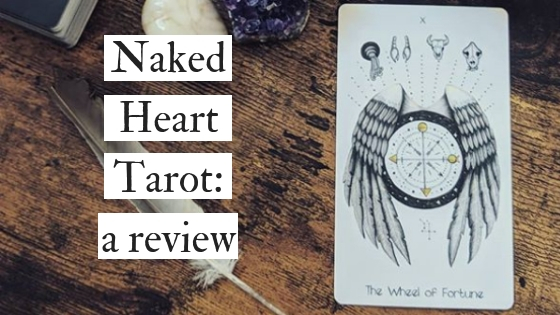
Naked Heart Tarot: a review
If you are like me, you are always looking to fuel your tarot deck lust. Luckily for you, I am here to do just that with this video review of the Naked Heart Tarot! Watch to learn all about this deck and hear all my riveting opinions.
Sign up for weekly updates and get the free ebook,
The Tarot Reader’s Daily Companion
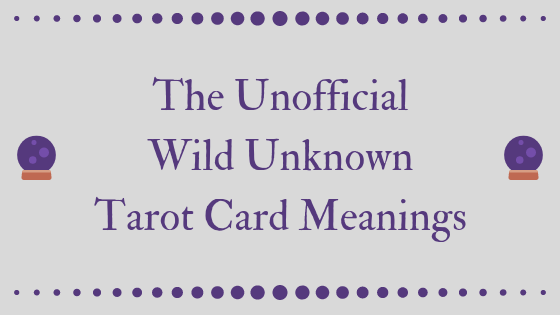
The Unofficial Wild Unknown Tarot Card Meanings: Download, Print, Love!
Back in 2015, I purchased the Wild Unknown tarot deck and was immediately hooked. I began a blog series to share my thoughts and unofficial interpretations of the cards. It took over a year to write the initial posts. In late 2017 I set out to update all of the original posts with better photos and additional information on each card. Those updates took another year! It is now 2018 and I’ve just finished putting the final touches on the series.
When I started this project, I was doing it to satisfy my own curiosity. But over the years I have received many emails and comments thanking me for creating these posts. I am so glad to know this project has been useful for you! I’ve received a lot of requests for a downloadable and printable version of my unofficial Wild Unknown tarot card meanings series. At long last, that is exactly what I have for you here!
I am offering this PDF download for free. However, if you are able to offer a contribution (suggestion: $10 USD) to support the energy I put into this project, I will be very grateful.
Contribute to the Tip Jar
A suggested $10 contribution would be an appreciated energetic exchange!
Download the PDF
Get the document via Dropbox, then make sure to click the DOWNLOAD link.
PLEASE NOTE BEFORE DOWNLOADING: writing these posts has been a labor of love. I am not affiliated with the Wild Unknown, Harper Elixir or Kim Krans. The deck is owned and copyrighted by Kim Krans and Harper Elixir. For official views on these cards, visit thewildunknown.com and purchase the official guidebook that accompanies the deck.
This PDF file contains all of the text from my original blog series, but does not contain images. This file is intended only for your personal use and studies. The text of the blog posts and the PDF file is the intellectual property of Carrie Mallon LLC.
Enjoy your tarot studies!
Sign up for weekly updates and get the free ebook,
The Tarot Reader’s Daily Companion
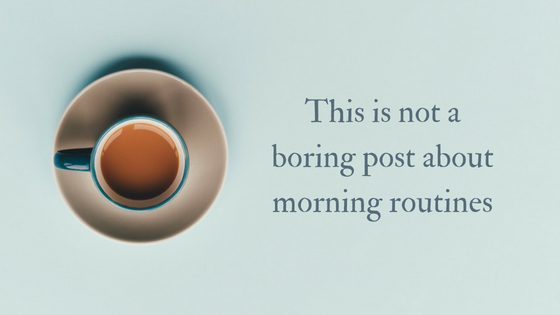
This is not a boring post about morning routines
Alright, people. This is not a boring post about morning routines… it’s an exciting one! Or at least an informative one! I know the internet is already brimming with posts about people’s picture-perfect morning routines, so I hesitated to write this. But the truth is that implementing a morning routine literally changed my life for the better. So here we are.
Why though?
Before I had my own morning routine, I was pretty cynical about the entire concept. Pssh, morning routines? That’s for people who roll out of bed happy and have all the time in the world to navel-gaze, not for people like me who hit the snooze button five times and then wake up grumpy and have to get to work.
At that time I was struggling with life. I kind of hated my job, I had low energy basically all of the time, and I was pretty inconsistent with doing the things that matter most to me like writing and exercising. I had a lot of brain fog and a lack of focus.
And look, I’m not going to act like starting a morning routine was some magic bullet, but it really did create some big shifts. Starting the day consciously – doing something meaningful, spiritual and intentional – lets you connect with yourself and get centered before you start your day. And at least for me, this led to experiencing greater clarity and focus throughout the entire day.
In case this needs to be said, giving yourself the gift of a morning routine is NOT selfish. Consistency in your morning routine leads you to your center, and this allows you to show up more lovingly for yourself AND for the people in your life. It is a win win all around.
How to create your own morning routine
When I suggest that my clients try out their own morning routine, one of the most common resistant points is time. I get this – I’m self-employed now, but when I first started my own morning routine I had a regular job. And as I’m not a “morning person” to begin with, I had to move through my own resistance about time. So if you decide to create your own routine, the first thing to do is think about how much time you want to devote to each morning.
What worked for me is simply getting up half an hour earlier, and setting a timer before I started my morning routine. What works for each of us is different – maybe you’ll only want a ten minute routine, or maybe you’ll want an hour. But for me, half an hour is that ‘sweet spot’ where it feels effective yet also allows me to get on with whatever’s on my schedule for the day.
Once you know how much time you’ve set aside, you get to the fun part: deciding what to do with that time. Remember that your routine does not have to look like anyone else’s! The whole point is to do something that makes YOU feel centered, grounded and connected to yourself. So start by asking yourself: what activities make me feel that way? For example, you might choose to implement any of the following (or something else entirely):
- Journaling.
- Meditation.
- Drinking tea or coffee.
- Tarot draws.
- Yoga.
- Ecstatic dance.
- Prayer.
- Reading poetry or a spiritual text.
- Chanting.
- Doodling.
- Sitting at your altar.
- Writing.
- Using affirmations or mantras.
- Walking.
- Lighting candles or incense or diffusing oils.
- Working with crystals.
- Rituals or spellcrafting.
- Listening to music.
- Creating art.
- Spiritual study.
The key is picking the things that actually speak to you, not the things you think you “should” do or that you saw someone else on the internet doing. Your routine will be the most nourishing when it is custom created to fit your weird little heart. It’s also okay to switch up your routine. The point isn’t to do the exact same thing every morning, the point is to give yourself some soul nourishment each morning, and your soul’s needs may vary from day to day.
My morning routine
I want to start by saying I am not perfect! Even though I’ve had some form of a morning routine for five or six years now, I definitely fall off the bandwagon from time to time (and always feel crappier when this happens). Some days I’m grumpy and feel like I’m just going through the motions, but I still do it. And I usually skip the weekends. So yeah – I’m not perfect, but it’s not about perfection.
That said, here’s what my morning routine looks like currently, on an ideal day. When my alarm goes off, I try really hard to resist the urge to check my phone. I’ve found that for me, getting on the news or social media straight away fucks with my energy. I do usually glance at my emails in case I have something important from a client, but other than that I TRY not to get sucked into smart phone land.
From there, I have a glass of water with lemon (I slice up a lemon each week and keep it in the fridge). I make breakfast (oatmeal and coffee most days) and say good morning to my partner and my fur babies. From here, the heart of my morning routine commences.
I head into my office – or, if the weather permits, I sit outside on the porch. With me I have my brekkie and coffee, two journals, my planner and a tarot deck. I eat my breakfast first thing because I’m always really hungry when I wake up. I take a look at my planner while I’m eating and make a to-do list for the day. I like doing the planning stuff first thing, because then my brain isn’t dwelling on logistics when I move on to the next portion of my routine.
Once my tummy is full and my planner is updated, I pull a tarot card of the day for myself. I use my Sacred Journey journal to record my card. This is pretty no-frills, I just notate the card and a sentence or two about how it might be applicable to my day. If I remember any dreams from the night, I also record them in this same journal.
From here, I either do some journaling, or do some meditation for however much time I have left. Several years ago, journaling WAS my morning routine. Back then I was doing daily ‘morning pages’ – a tool from the Artist’s Way, morning pages are three pages, written long hand, done daily to get all the gunk out of your brain. If you are feeling reaaallly stuck, I highly recommend morning pages. But at this point, for me, three pages is overkill. I just write a page or two on days when the mood strikes.
As for meditation, I mentioned that back in June I was doing an hour a day. I’ve adjusted this slightly, and found that about twenty minutes is my ‘sweet spot’ for meditation. I’ve been taking a course in iRest meditation, which is based off Yoga Nidra, and I’ve found this modality works better for me than more traditional seated meditations.
And that’s it! This current incarnation of my morning routine usually takes around 45 minutes. Of course, as I already said, I don’t tell you this so that you can make your routine look just like mine. This is just to give you an idea of what a morning routine might look like.
Do it!
All those years ago, before I had my own morning routine, I remember wanting to roll my eyes when I heard people talk about them. I thought they were for people with all the time in the world for navel-gazing and I thought I could never be one of “those people.” But I have to say this again…
Having a morning routine DID change my life. And it continues to change my life.
If you are able to get in a bit of self-care in the morning, you know you’ve filled your tank that much. If you wait until later in the day to do the things that evoke your soul, it’s a lot easier for them to end up being forsaken. I am a firm believer in doing the things that matter first, and what matters the most in your life is taking care of yourself. My meditation teacher always brings up a quote that goes something like this: “self-care is not selfish. In fact, it is selfless. When you take care of yourself, you are then able to give to others without resentment.”
You matter. Your spiritual connection matters. Carve out the space in your life to connect with yourself each morning, and I guarantee your heart will feel lighter and brighter, and the world needs you at your lightest and brightest!
Sign up for weekly updates and get the free ebook,
The Tarot Reader’s Daily Companion
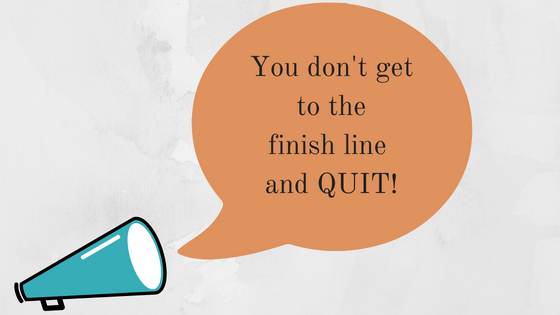
You don’t get to the finish line and quit
I like starting things. Starting things is sexy and exciting, at the beginning of each new project things feel brimming with potential and momentum. I’m great at starting things! But you know what I’m not so good at?
….finishing things.
It’s true, and I know I’m not alone. A lot of people I talk with say that the hardest part of any work comes at about the 80% mark. By this point the initial enthusiasm has worn off and things no longer feels so sexy. By the 80% point you might be grappling with self-doubt or apathy or burn out. Maybe you’re even wondering wtf you were thinking when you started. Maybe you kind of want to give up.
A few years ago my friends and I used to do this silly workout DVD hosted by the trainer Jillian Michaels. Near the end of the workout routine Jillian says “you don’t get to the finish line and quit! That’s when you put in even more than when you started!” This line became a sort of mantra my friends and I would half-jokingly quote to each other, but silly as it is, this quote has stayed with me.
Right now I have a few projects languishing even though the finish line is in sight. One of those projects involves updating all of my Wild Unknown card interpretations – over the last year or so, I’ve updated all of them except the suit of wands. That’s only 16 out of 78 cards remaining…yet I haven’t touched the posts in months! Sure, I’ve been working on other things, but that’s just an excuse. The real reason I haven’t finished the posts yet is that…
FINISHING PROJECTS IS HARD. It’s satisfying, yes. It’s fulfilling, yes. It’s rewarding, yes. But it’s certainly not always easy. You’ve got to push through your resistance. You’ve got to remember why you started. You’ve got to keep putting one foot in front of the other (either metaphorically or literally). You’ve got to keep doing the work.
Steven Pressfield talks about this in one of my favorite books, The War of Art. Pressfield writes:
“The danger is greatest when the finish line is in sight. At this point, Resistance knows we are about to beat it. It hits the panic button. It marshals one last assault and slams us with everything it’s got. The professional must be alert for this counterattack. Be wary at the end. Don’t open that bag of wind.”
So, comrades, this is a reminder for you as well as for me. I’m re-committing to finishing updating those Wild Unknown posts. It shall be done, I speak it out loud. What is it that you’ve been resisting even though the end is in sight? Speak it out loud, dedicate yourself to getting it DONE. Remind yourself that you don’t get to the finish line and quit! You CAN do this. Prep yourself. Crack yer knuckles. Tell resistance and excuses to take a seat. And press onwards.
We’ve got this.
Sign up for weekly updates and get the free ebook,
The Tarot Reader’s Daily Companion
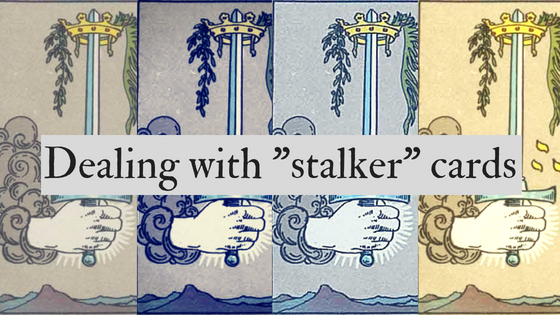
Dealing with “stalker” cards
Sometimes a certain card just does NOT want to leave you alone. If you’ve been practicing tarot for a while you’ve probably had this experience of seeing the same card come up again. And again. And again! A lot of tarot readers refer to these as ‘stalker’ cards, and today we’re going to talk about how you might effectively work with them.
When you notice you have a stalker card, the first thing I advise doing is checking in with your gut reaction. I’ve noticed when people talk about their stalker cards, they often have some dismay (“oh no, not the Emperor AGAIN!”). This dismay is an indicator that you have resistance to the message of the card. And as long as you’re in resistance to the message, it won’t be able to sink in, and the card will keep showing up. If your gut reaction to the card is to immediately groan, that is an invitation to look deeper.
I am of the belief that the only useful messages from the cards are the messages that are in alignment with my highest good, and the highest good of the universe. I affirm this belief often to myself, and it has fully infused itself into my tarot practice. If this resonates with you, it might be helpful to remind yourself of this belief any time you experience resistance to a card.
Stalker cards are never there to taunt you, to bring you down, to cause you harm. They are there because they want to offer you an important message, a message that is in alignment with your highest good. When you consider your stalker card, try looking at it through this framework. Approach the card with openness and curiosity. Set aside any notions that the card is telling you something ‘bad.’ Working with the assumption that the message will be supportive puts you in the right headspace to connect with that supportive message.
From here, I’ve found that journaling is one of the most effective things you can do to delve further into why a card keeps showing up. Here are a few prompts to get you started:
What is my initial reaction to seeing this card repeatedly?
What don’t I want to acknowledge about this card?
What am I afraid this card is telling me?
How can I reframe this so that the card’s message is empowering and useful?
Occasionally I will draw one clarifying card to give me some further clues as to what my “stalker” card is trying to convey. If you choose to draw a clarifying card, I do suggest keeping it to ONE card… otherwise you can end up pulling card after card, and only getting the message more and more obscured!
When you’ve gone as far as you can relying on your own intuition, there is never anything wrong with using references. Check in with trusted books or blogs and see if they have any musings on the card that might spark something for you. I suggest limiting yourself to using maybe 2-3 resources – this is so you don’t get information overload and end up even less certain than you started out. Remember that the resources are there to offer fresh insights and draw out your own inner knowing, NOT to give a cookie-cutter answer.
There is another caveat here too: one of the worst ways you can react to a stalker card is by getting too hung up on figuring out what it means. Sure, it can be useful to read about the card on various books and websites. Sometimes doing some research and getting other people’s perspectives is EXACTLY what you need to figure out what your stalker card is telling you.
But it’s certainly possible to go too far with this urge to solve the puzzle! I suggest affirming to yourself that on a gut level, you already know what this card is telling you. Tarot works primarily by connecting with your unconscious mind. Sometimes you’ll see a card and on an unconscious “gut” level, it connects right away… but it takes a while for your conscious mind to catch on.
If you find yourself feeling frustrated or brain-foggy when you think about your stalker card, it’s a good indication that you need to give it a rest with the FORCING. Sleep on it. Meditate on it. Go for a walk. Maybe even set aside the cards for a few days to give yourself a chance to process. You want to get out of the “OMG WHAT DOES THIS MEAN I HAVE TO FIGURE IT OUT” frantic energy and into an energy of openness. Create spaciousness so that the messages of your stalker card have room to come forward.
A lot of what I’ve been talking about so far is applicable when you’re really not sure quite what your stalker card is trying to tell you. But it’s worth mentioning that sometimes a card keeps showing up even when you’re pretty sure you know what the message is. In this case, there are two possibilities. The first, and most common, is that even though you know what the card is telling you, you aren’t implementing it. In these circumstances, the stalker card is coming back as a reminder that understanding what it represents isn’t enough: you need to actually IMPLEMENT that understanding!
The second possibility is that even though you got the message, you now need to get a slightly different angle of that message. As an example, my latest stalker card is the Emperor. The first time the card showed up for me, I immediately knew what it was trying to tell me. I wasn’t in resistance, and I WAS trying to implement the message. When I drew the same card only a couple of days later, it was clear that this time the card had a slightly different message than the first time.
I hope this post helps! As often happens, there’s a lot more to say but we’ll leave it here for now. In conclusion, when you see a card over and over again, pay attention. Be receptive. Move out of resistance. It isn’t a coincidence that you keep seeing the same tarot card – that card has something to teach you, and with some patience and self-compassion, the message will open doors within you.
Sign up for weekly updates and get the free ebook,
The Tarot Reader’s Daily Companion
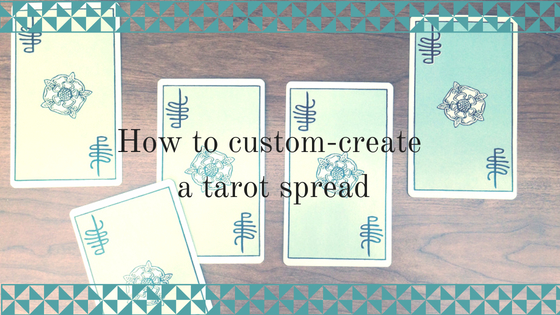
How to custom-create a tarot spread
When I read tarot for my clients, I almost always use customized spreads. Putting together a spread can be an enjoyable creative process, plus it allows me to really hone in on each specific seeker’s needs. In this post, I’m sharing the process I use to create a tarot spread. It’s pretty straightforward, but perhaps it will be useful to someone!
Before I move forward with a reading, I always invite the seeker to share their story with me. When I first started reading tarot, I’d advise people to come into the reading with a specific question, but I abandoned that a few years ago. For my reading style, it has proven more useful to just ask what has led them to seek a reading, inviting them to share as much or as little as they’d like.
Once I’ve heard back from the seeker, I hone in on certain things they’ve mentioned that feel particularly ripe for exploration. This determines a lot of the spread positions I use. For example, if someone mentions they’ve been feeling drained and tired lately, I might include a spread position for considering the root cause of the tiredness, and perhaps another spread position for advice on navigating that energy. This is just about actively listening to what a seeker shares and using your intuition to hone in on correlating spread positions to integrate.
Although I really like my spreads to be focused and concise, I also find it’s really useful to incorporate open-ended spread positions. Here are some common spread positions I use that can add value to almost any tarot spread:
- opening messages
- themes
- challenges
- strengths
- advice
- unseen factors
- energy to release
- energy to bring in
- unconscious influences
- conscious influences
- current energy at work
- advice on navigating current energy
- lessons available
- blessings
- blocks
- synthesis
- closing messages
I’ve found that my ‘sweet spot’ for spread crafting is 3-8 positions. Occasionally I will do a bigger spread, but sometimes bigger spreads feel a bit too bloated for me. This is something that varies from reader to reader, so if you’re just starting out with creating spreads, play around and see what feels right for you.
Once I’ve selected all the spread positions, I then put them in an order that ‘flows’ so that the spread can read as a sort of story. That probably goes without saying, but as an example: starting with opening messages, then moving into the core spread positions, then perhaps rounding it out with more open-ended messages and a closing message.
At this point, some readers like to arrange their spread into a specific shape that fits the theme of the reading. I like this idea, but in application I honestly hardly do this – I usually just lay the cards out however they fit on my desk! But if you’re feeling particularly creative, it’s nice to find a visually appealing way to present your spread.
And that’s about it! At this point, the spread is finalized and the reading can commence. And if you’ve created a really good spread, you’re on the right track to offering a really powerful reading. Happy spread crafting!
Sign up for weekly updates and get the free ebook,
The Tarot Reader’s Daily Companion
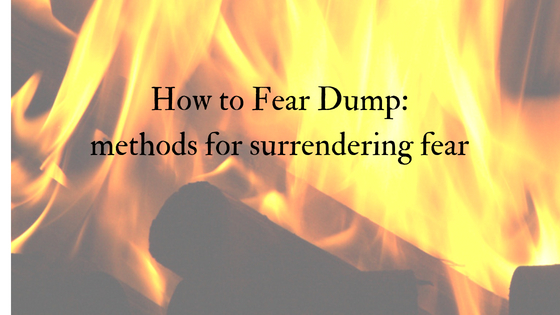
How to Fear Dump (methods for surrendering fear)
There’s this interesting thing that happens to a lot of people when they start a creative project or embark on any type of positive life change. Maybe you can relate? It goes something like this: you get an idea. The idea excites you. You get ready to breathe some life into this idea and then… fears come swooping in like an angry swarm of bees. The exact fears look different depending on you and your situation, but they’re commonly things like:
I’m not good enough to do this.
This has already been done.
I don’t know where to start.
I’m going to fuck this up.
And on, and on, and on. I’ve been in this swarm of fears enough times (and worked with enough clients navigating these types of fears) that I’ve established pretty effective counterarguments against them. But your fears don’t always respond to counterarguments. Sometimes your fear doesn’t want to be reasoned with – it just wants to be heard and released. Hence, the importance of Fear Dumping.
The Fear Dump (let’s skip the bathroom jokes) is an exercise that I first came across in The Artist’s Way.The purpose of the Fear Dump is to first identify your fears, then surrender them. I suggest doing a fear dump right when you begin any project, but it can also be useful to do at any point fears threaten to stifle your progress. Once you have dumped your fears, you’ll feel energetically lighter and ready to move forward.
To begin, you’ll be doing some writing using either a word document or a notebook. Write FEAR DUMP across the top of the page, and then list every fear that is coming up for you. Remember that the idea here isn’t to “overcome” these fears, just to describe them. This simple act of diving into your fears, bringing them out of your head and onto the paper, can work wonders. As I mentioned earlier, sometimes your fears just want to be acknowledged. Writing them down is a form of acknowledgement.
Now that you’ve written out your fears, you are ready to symbolically surrender them. If it works with your belief system, you might set the intention to surrender your fears to the Universe or to a deity. The idea here is that you no longer need to be energetically responsible for tending to those fears. You are turning them over to a higher power. You are releasing. You are surrendering.
There is no right or wrong way to engage in this symbolic surrender, so do so in whatever way speaks to you. I have tried three different methods, and found all of them to be useful. The first and simplest method is to add a written affirmation of surrender at the bottom of your fear dump, such as: I release acknowledge these fears and release them to the Universe. I am no longer energetically bound by these fears as they are surrendered to the cosmos. It is also helpful to recite your affirmation out loud once you have written it down.
The second method is to create what Julia Cameron calls a “God Jar.” If the word god doesn’t resonate with you, you could interchange it with whatever framework speaks to you. Find a mason jar or other container. Label it “God Jar.” Then return to your written fears, cutting the paper up so that each fear is on one slip. Put each slip into the jar, and let this be a symbolic representation of turning your fears over to God. A bonus of creating a God Jar to is that you can keep it somewhere handy and surrender any new fears that crop up in the future.
The third method I’ve used is good old fashioned fire. Take your list of fears and burn it. Set the intention that as you burn this list, you are surrendering these fears back to the primal forces of the universe.
Keep in mind that Fear Dumping can be really liberating, but it doesn’t always eradicate your fears right away. Any creative person will tell you that fear is a constant companion. It’s not realistic to try to be fearless. Instead, your energy is better spent on acknowledging fear and affirming that you will not be its prisoner. Remember that you don’t work for fear – fear works for you. And since you are the boss, you can choose to surrender fear as often as necessary.
Sign up for weekly updates and get the free ebook,
The Tarot Reader’s Daily Companion

Sell your cleverness and buy bewilderment
The Moon is one of my favorite cards in any deck (even though I try not to play favorites, each card is important to me in its own way). I came across a quote from Rumi this week, one I’d never heard before, and it felt very in alignment with the tarot’s Moon archetype:
“Sell your cleverness and buy bewilderment.
Cleverness is mere opinion, bewilderment is intuition.”
The concept of bewilderment speaks to me always, lately stronger than ever. I think it’s something we are craving as a collective right now. There is a way of being that is other than clever. Human beings like to pretend we are civilized. We like to act civilized. We are afraid of bewilderment because we confuse it with being rabid or insane or scary or gasp, just not knowing everything (not to know – the HORROR!). And to be fair, sometimes bewilderment does contain a hint of those elements.
But bewilderment is also about being in touch with primal rhythms, it’s about remembering that what we call “reality” is only one aspect of the Big Picture. Bewilderment is about being in touch with magic, synchronicities, the collective unconscious.
And bewilderment is also about forgoing attempts to know everything. Cleverness, although not without merit to a fully functioning human, is about attempts to understand. Cleverness is about conceptualizing, analyzing, keeping yourself at a cognitive distance from the direct experience of being human. And bewilderment is about eradicating that distance, about immersing in that direct experience.
There’s a lot more I could say about this, but even trying to write this post is in some ways an attempt at being clever. I don’t know how to explain everthing I want to say here, I’m at a loss of putting out further words to convey any point. And that’s okay, it’s necessary, it’s part of embracing my birthright of bewilderment.
Sign up for weekly updates and get the free ebook,
The Tarot Reader’s Daily Companion
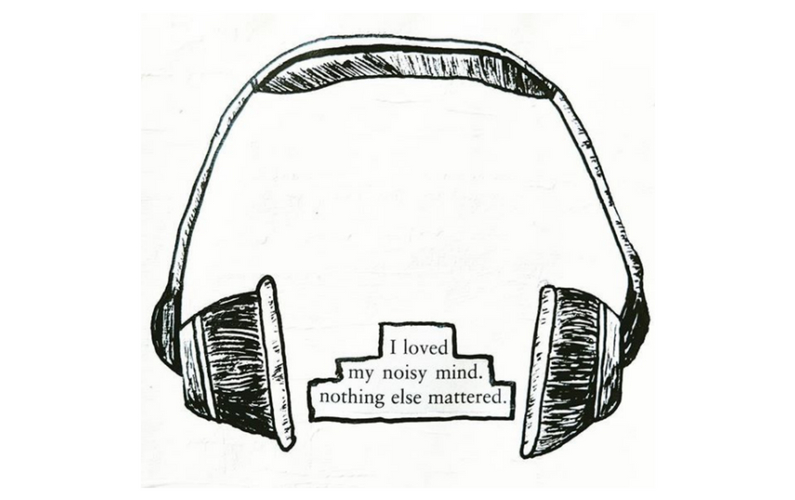
I love my noisy mind
I meditated every day during June, and here is the main thing I learned: for me, meditation is not about silencing my mind. Meditation is about being less attached to my thoughts, stepping into a state of awareness, not assuming that my thoughts are what defines me.
I’ve gotten frustrated in past attempts at meditation because I am rarely able to completely quiet my thoughts. In fact, sometimes when I sit down to meditate my thoughts intensify. Even though in my (very brief) studies of meditation modalities, I’ve seen it said that meditation is NOT about stopping the thoughts, it’s about less attached to them, letting them pass like the weather. Even so, I’ve always felt like I wasn’t “doing it right” because my brain often insisted on being so loud during meditation.
During June I started attending a weekly meditation class. This teacher uses iRest meditation (iRest = integrative restoration) which is a modernized, westernized interpretation of traditional yoga nidra. One thing I really like about this approach is that we are not guided to let go of our thoughts. Instead, we are guided to become deeply aware of our bodies. When I am able to connect more with my body, I do very much find that my thoughts are less overwhelming.
This all probably sounds quite “duh” to anyone with more meditation knowledge and experience, but it’s been a big shift for me. Most of the meditation I’ve tried in the past was in the framework of focus on the breath, let thoughts go. But I’d often find myself sitting there thinking about letting thoughts go, then thinking about how I wasn’t letting thoughts go, and basically getting deeper and deeper into a mental wormhole quite counter to the entire point of a meditation practice.
And on a personal level, I’ve also been working on simply accepting the fact that I have a noisy mind. The noisiness inside my head is something I often try to resist, and sometimes it is not an ideal experience (hi anxiety). But on the otherhand, the noisiness in my head is also what leads me to contemplate life in deeper ways. It is what leads me to question, to experience, to create.
I’m planning to continue my daily meditation practice for the forseeable future, but not with the goal of eradicating the noisiness of my mind. It is useful to create distance from my thoughts, to be in my body, to know that I am more than my mental ramblings. But I’m also embracing the fact that alongside all the noise, my brain also makes a pretty damn beautiful symphony.
Sign up for weekly updates and get the free ebook,
The Tarot Reader’s Daily Companion
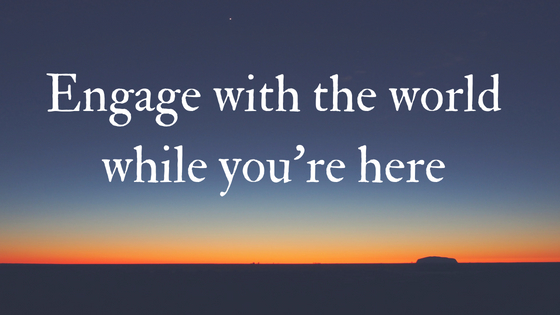
Engage with the world while you’re here
I told myself I’d write a blog post every day this week but I skipped yesterday. It was Saturday, and I was out in the world doing many things: reuniting with a friend I haven’t seen in nearly two years, attending a Families Belong Together protest, making vegan chocolate chip cookies, attending a backyard concert and potluck, and then hanging out in front of a firepit with friends. Whew! That was a lot for one day. But it was a good day, full of nourishment and connection.
A couple of years ago around this time I wrote a post about going “without” aka taking a break from introspection. There’s something about this post-solstice time of the summer when the days feel so long and radiant and warm that makes me want to get TF out of my own head for a while. Not because I’m trying to avoid inner work, but because when you’re a naturally introspective person it is actually possible to overload on the whole “going within” modality.
Going to the protest was especially re-energizing. I’ve certainly been upset over the current events in America. Getting together with people in person(instead of just yelling at each other on social media) felt really important. It is always encouraging to see the vast number of people who are willing to come to an event in support of what is right. Even if it was just in a small way, I’m glad I was a part of that.
What else? I’m sitting out on my porch as I write this. My husband is next to me reading. My mutt, Sokka, is resting between excitedly squiggling his butt at anyone who walks by. I’m about to start sipping an herbal tea cold infusion. This world is not a perfect place, but it is the place I find myself in right now, and I want to engage with it while I’m here.
Sign up for weekly updates and get the free ebook,
The Tarot Reader’s Daily Companion
Carrie Mallon
Header art from The Spacious Tarot illustrated by Annie Ruygt
All site content © Carrie Mallon LLC 2014-2019
Sign up for weekly updates


 I'm a tarot reader and mentor.
I'm a tarot reader and mentor. 